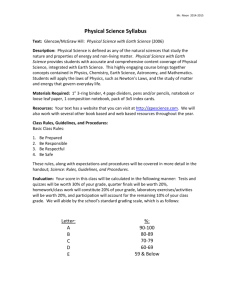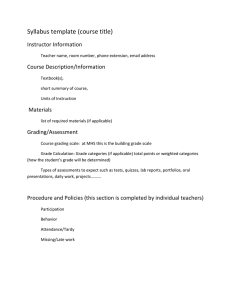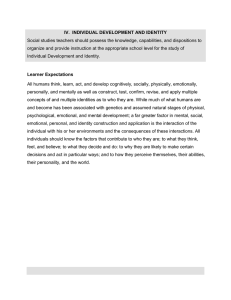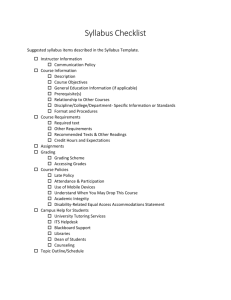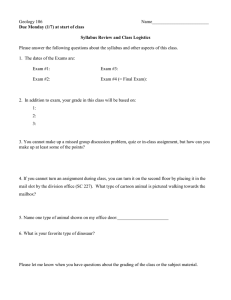Chemical Measurement Laboratory (CHEM 205)
advertisement
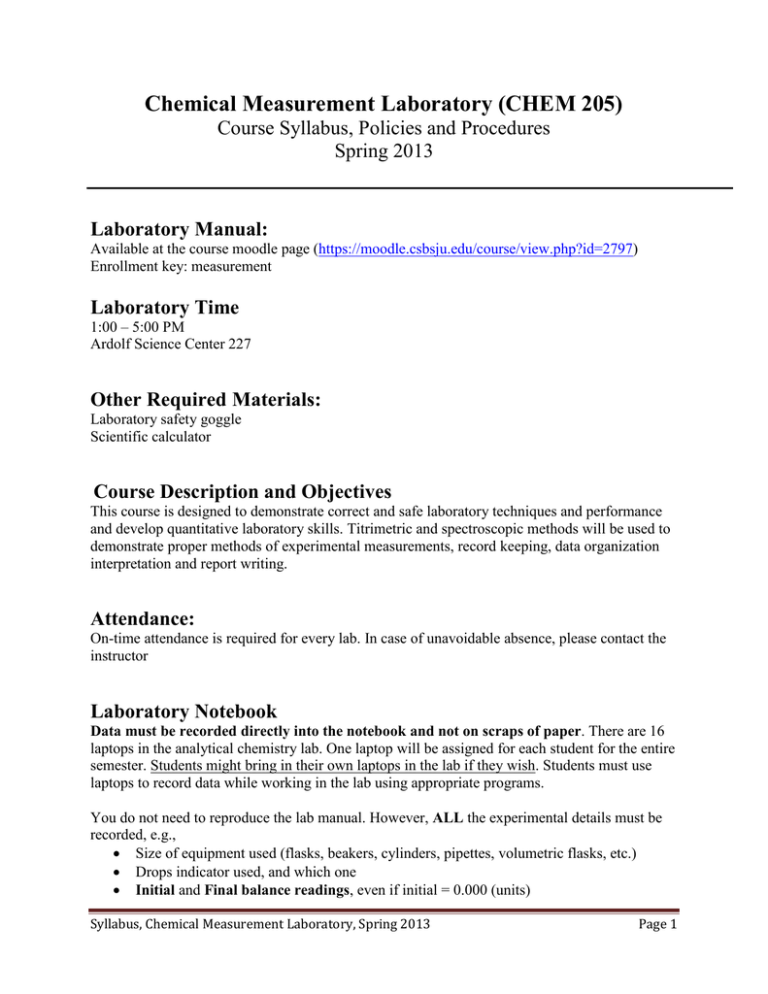
Chemical Measurement Laboratory (CHEM 205) Course Syllabus, Policies and Procedures Spring 2013 Laboratory Manual: Available at the course moodle page (https://moodle.csbsju.edu/course/view.php?id=2797) Enrollment key: measurement Laboratory Time 1:00 – 5:00 PM Ardolf Science Center 227 Other Required Materials: Laboratory safety goggle Scientific calculator Course Description and Objectives This course is designed to demonstrate correct and safe laboratory techniques and performance and develop quantitative laboratory skills. Titrimetric and spectroscopic methods will be used to demonstrate proper methods of experimental measurements, record keeping, data organization interpretation and report writing. Attendance: On-time attendance is required for every lab. In case of unavoidable absence, please contact the instructor Laboratory Notebook Data must be recorded directly into the notebook and not on scraps of paper. There are 16 laptops in the analytical chemistry lab. One laptop will be assigned for each student for the entire semester. Students might bring in their own laptops in the lab if they wish. Students must use laptops to record data while working in the lab using appropriate programs. You do not need to reproduce the lab manual. However, ALL the experimental details must be recorded, e.g., Size of equipment used (flasks, beakers, cylinders, pipettes, volumetric flasks, etc.) Drops indicator used, and which one Initial and Final balance readings, even if initial = 0.000 (units) Syllabus, Chemical Measurement Laboratory, Spring 2013 Page 1 Same for all other measurements (What was the reagent? concentration?) Data must be organized and complete enough for easy reproduction Laboratory notebooks will be collected periodically and graded. The grade will contribute to your overall laboratory grade. Writing Lab Reports: At the completion of an experiment, you are required to write a full or partial laboratory report. The full laboratory report should have a cover page with the title of the project, the course name, number and date of the report. It will also have the following subtitles: Introduction: 1 (or 2) paragraphs to introduce the purpose of the project the goal you set out to accomplish. Experimental Procedure: A brief description of how you conducted the experiment Results and Discussions: Interpretation of your data and conclusions of the project. For more information on writing lab reports go to the course moodle page (“Write like a chemist”) Repeated Experiments Once an experiment has been completed and submitted for grading, it cannot be repeated. Deadlines for Reports In general, each experiment will take 1-2 laboratory periods. The results and reports will usually be due about one week after the experiments are finished. Check the “Laboratory Schedule” for exact deadlines. Late-submission Policy All unknown results and written reports are due at the beginning of the lab. Late reports will lose 20% per day late and will not be graded if they are more than 3 days late. Missed Lab Policy Students having a valid excuse (funerals, illness, athletic events etc.) may reschedule a missed lab, if possible, only if they notify the lab coordinator (Dr. Fazal, mfazal@csbsju.edu) before the regularly scheduled lab. Recalculated Results In the event that the results submitted for grading for an experiment were miscalculated, one recalculation will be permitted. The grade on that experiment will be the average of the original and the recalculated grade. Syllabus, Chemical Measurement Laboratory, Spring 2013 Page 2 Grading: In this course you will finish five laboratory projects and one final project. Each project will take about 1 - 2 laboratory periods and will count 100 points except the final project (150 points). Some of the projects will be graded on the quantitative results only, others will be graded on the discussion (report) of the experiment, and some on both the results and the report. In addition, you will you will be taking five in-lab quizzes. The quizzes are designed to help you understand the relevant chemical principles for the projects. Final grades will be assigned on the basis of percentages rather than a curve. This means that any number of students may earn any grade. Exam types Comments % Contribution Quizzes Projects Final Exam. 5 X 20 = 100 5 X 100 = 500 150 13.33% 66.66% 20.00% Percentage of points Assigned grade 90% and up 85% - 89.99% 80% - 84.99% 75% - 79.99% 70% - 74.99% 65% - 69.99% 60% - 64.99% A AB B BC C CD D Academic Ethics: Original work performed in good faith is assumed on all laboratory work. It is presumed that the data you record and report in laboratory is your work. Scientific and scholarly misconduct includes the following forms of inappropriate activities: Plagiarism (e.g., copying from other students, past reports, or writing of others etc.) Intentional misrepresentation of credentials Falsification of data Failure to adhere to this code of ethics will result in prosecution to the fullest extent (http://www.csbsju.edu/catalog/2007_2009/programs/rights/001.htm). If you have not done something yourself, do not attempt to pass it as original work. Syllabus, Chemical Measurement Laboratory, Spring 2013 Page 3 List of Projects: Project Number Title Project #1 Introduction to Analytical Laboratory Techniques: Calibration of Volumetric Glassware and Thermometer Project #2 Electrochemical Detection of a Titration Endpoint Project #3 Determination of Unknown Protein Concentration Project #14 The Vapor Pressure of a Pure Liquid Project #5 Quantifying Molecules and Light Interaction Final Project Determination of % KHP in Unknown Sample Using Acid-base Titration Distribution of Points Project Number Results Report Total Project #1 80 20 100 Project #2 80 20 100 Project #3 80 20 100 Project #4 60 40 100 Project #5 60 40 100 Final project 150 - 150 Syllabus, Chemical Measurement Laboratory, Spring 2013 Page 4 Chemical Measurement Laboratory (CHEM 205) Lab Schedule Spring 2013 ALL Sections Cycle # Reading In-Class Assignment Review In the Lab Cycle 1 Project #1 Work on project 1 (individual) Work on project 1 (individual) Work on project 2 (Individual) Work on project 2 (individual) Work on project 3 (Group**) Work on project 3 (Group**) Work on project 4 (Group**) Work on project 4 (Group) Work on project 5 (Group**) Work on project 5 (Group**) Final Project (Individual) Cycle 2 Cycle 3 QZ: Project #1 Project #2 Cycle 4 Cycle 5 Project #3 Cycle 10 Cycle 11 Project #3 QZ: Project #3 Project #4 Cycle 8 Cycle 9 Project #2 QZ: Project #2 Cycle 6 Cycle 7 Project #1 Project #4 QZ: Project #4 Project #5 Project #5 QZ: Project #5 Cycle 12*** Report Due* Report: Project #1 (Individual) Report: Project #2 (Individual) Report: Project #3 (Individual) Report: Project #4 (Group**) Report: Project #5 (Individual) Report: Final Project (Individual) *Reports are due at the beginning of the lab ** Two students per group ***No lab work is allowed in cycle 12 Syllabus, Chemical Measurement Laboratory, Spring 2013 Page 5
